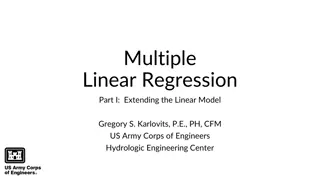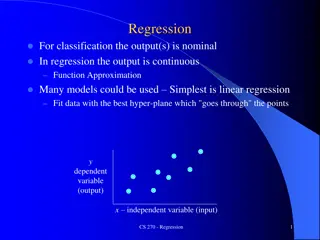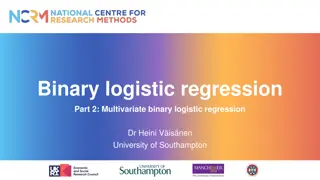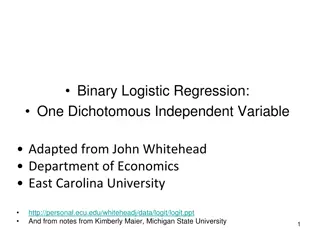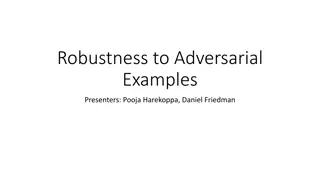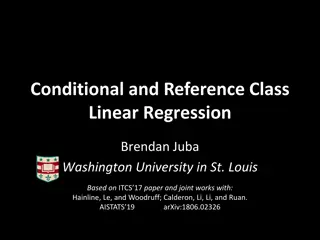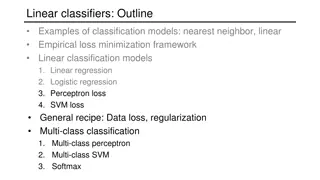Understanding Machine Learning Concepts: Linear Classification and Logistic Regression
Explore the fundamentals of machine learning through concepts such as Deterministic Learning, Linear Classification, and Logistic Regression. Gain insights on linear hyperplanes, margin computation, and the uniqueness of functions found in logistic regression. Enhance your understanding of these key concepts in the field of data science.
Download Presentation

Please find below an Image/Link to download the presentation.
The content on the website is provided AS IS for your information and personal use only. It may not be sold, licensed, or shared on other websites without obtaining consent from the author. Download presentation by click this link. If you encounter any issues during the download, it is possible that the publisher has removed the file from their server.
E N D
Presentation Transcript
Dr. Jianlin Cheng Department of Electrical Engineering and Computer Science University of Missouri, Columbia Fall, 2019 Slides Adapted from Book and CMU, Stanford Machine Learning Courses
Deterministic Learning Machine Learning a mapping: xi | yi. The machine is defined by a set of mappings (functions): f(x, a) f(x,a) are defined by the adjustable parameters a. The machine is assumed to be deterministic. A particular choice of agenerates a trained machine (examples?)
Linear Classification Hyperplane A set of labeled training data {xi, yi}, i = 1, , l, xi in Rd, yi in {-1, 1}. A linear machine trained on the separable data. A linear hyperplane f(x) = w.x+b, separates the positive from negative examples, w is normal to the hyperplane. The points which lie on the hyperplane satisfy w.x + b = 0, positives w.x+b > 0, and negatives w.x+b < 0.
+ w - wx + b = 1 wx + b = 0 wx + b = -1 Origin xi . w + b >= +1 for yi = +1 xi . w + b <= -1, for yi = -1 combined into: yi(xi.w+b) >= 1 Comments: equivalent to general form yi(xi.w+b) >= c
+ x1 w x2 - wx + b = 1 wx + b = 0 wx + b = -1 Prove w is normal (perpendicular) to the hyperplane (x2 x1) . w = x2.w x1.w = -b (-b) = 0
+ w |b| |w| - wx + b = 1 wx + b = 0 wx + b = -1 Origin
Distance from origin to wx + b=0 is |b| / |w| + x w |b| |w| - wx + b = 1 wx + b = 0 Origin wx + b = -1 Choose a point x on wx+b=0 such that vector (0, x) is perpendicular to wx+b = 0. So x is w because w is norm of wx+b=0. So w.w+b = 0 = -b/ w.w = -b / |w|2 So x = -b / |w|2 *w |x| = |b| / |w|.
Q1: How logistic regression finds a linear hyperplane? Is the function found by logistic regression unique? 1 2 3 Q2: From your intuition, which one is better?
Margin M wx + b = 1 wx + b = 0 wx + b = -1
How to Compute Margin? A. Moore, 2003
x+ w x- wx+b = +1 wx+b = 0 wx+b = -1 x+ = x- + w origin
Constrained Optimization Problem A. Moore, 2003
Margin and Support Vectors H1 H Support vectors, lying on the hyperplane H2 M = 2 / |w| wx + b = 1 wx + b = 0 wx + b = -1
Relationship with Vapnik Chevonenkis (VC) Dimension Learning Theory
Expectation of Test Error 1 2 = ( ) | ( , )| ( , ) f X a R a y p X y dXdy R(a) is called expected risk / loss, the same as before except the ratio. Empirical Risk Remp(a) is defined to be the measured mean error rate on l training examples. 1 l = i = ( ) | ( , | ) R a y f X a emp i i 2 l 1
Vapnik Risk Bound |yi f(Xi, a)| is also called the loss. It can only take the values 0 and 1. Choose such that 0 <= <= 1. With probability 1 , the following bound holds (Vapnik, 1995) + (log( 2 / ) ) 1 l log( ) 4 / h l h + ( ) ( ) ( ) R a R a emp Where h is a non-negative integer called the Vapnik Chevonenkis (VC) dimension, and is a measure of the notion of capacity. The second part of the right is called VC confidence.
Insights about Risk Bound Independent of p(X,y). Often not possible to compute the left hand side. Easily compute right hand side if h is known. Structural Risk Minimization: Given sufficiently small , taking the machine which minimizes the right hand side and gives the lowest upper bound on the actual risk. Question: how does the bound change according to ?
VC Dimension VC dimension is a property of a set of functions { f(a) }. Here we consider functions that correspond to two-class pattern recognition case, so that f(X,a) {-1, +1}. If a given set of l points can be labeled in all possible 2l ways, and for each labeling, a member of set {f(a)} can be found to correctly assign those labels, we say that set of points is shattered by that set of functions.
VC Dimension VC dimension for a set of functions {f(a)} is defined as the maximum number of training points that can be shattered by {f(a)}. If the VC dimension is h, then there exists at least one set of h points that can be shattered. But not necessary for every set of h points.
A linear function has VC dimension 3 8 possible labeling of 3 points can be separated by lines.
Simply can not separate the labeling of these four points using a line. So the VC dimension of a line is 3.
VC Dimension and the Number of Parameters Intuitively, more parameters higher VC dimension? However, 1 parameter function can have infinite VC dimension. (see Burge s tutorial) If sin(ax) > 0, f(x,a) = 1, -1 otherwise
VC Confidence and VC Dimension h 2 (log( ( ) ( ) ( a R a R emp + + / ) ) 1 l log( ) 4 / h l h ) VC confidence is monotonic in h. (here l = 10,000, = 0.05 (95%))
Structural Risk Minimization + (log( 2 / ) ) 1 l log( ) 4 / h l h + ( ) ( ) ( ) R a R a emp Given some selection of learning machines whose empirical risk is zero, one wants to choose that learning machine whose associated set of functions has minimal VC dimension. This is called Occam s Razor: "All things being equal, the simplest solution tends to be the best one."
Comments The risk bound equation gives a probabilistic upper bound on the actual risk. This does not prevent a particular machine with the same value for empirical risk, and whose function set has higher VC dimension from having better performance. For higher h value, the bound is guaranteed not tight. h/l > 0.37, VC confidence exceeds unity.
Example What is the VC dimension of one-nearest neighbor method? Nearest neighbor classifier can still perform well. For any classifier with an infinite VC dimension, the bound is not even valid.
Structure Risk Minimization for SVM Margin (M) is a measure of capacity / complexity of a linear support vector machine The objective is to find a linear hyperplane with maximum margin Maximum margin classifier
Lagrange Optimization An mathematical optimization technique named after Joseph Louis Lagrange A method for finding local minima of a function of several variables subject to one or more constraints The method reduces a problem in n variables with k constraints to a solvable problem in n+k variables with no constraints. The method introduces a new unknown scalar variable, the Lagrange multiplier, for each constraint and forms a linear combination involving the multipliers as coefficients. http://en.wikipedia.org/wiki/Lagrange_multipliers
Primal and Dual Problems Primal f(w*) Dual
Proof (
Support Vector Machines Question: how to get b?
How to Determine w and b Use quadratic programming to solve ai and compute w is trivial. (use KKT condition (1)) How to compute b? Use KKT condition (5), for any support vector (point ai > 0), yi(w.xi+b)-1 = 0. We compute b in terms of a support vector. Better: we computer b in terms of all support vectors and take the average.
Interpretation of Support Vector Machines


